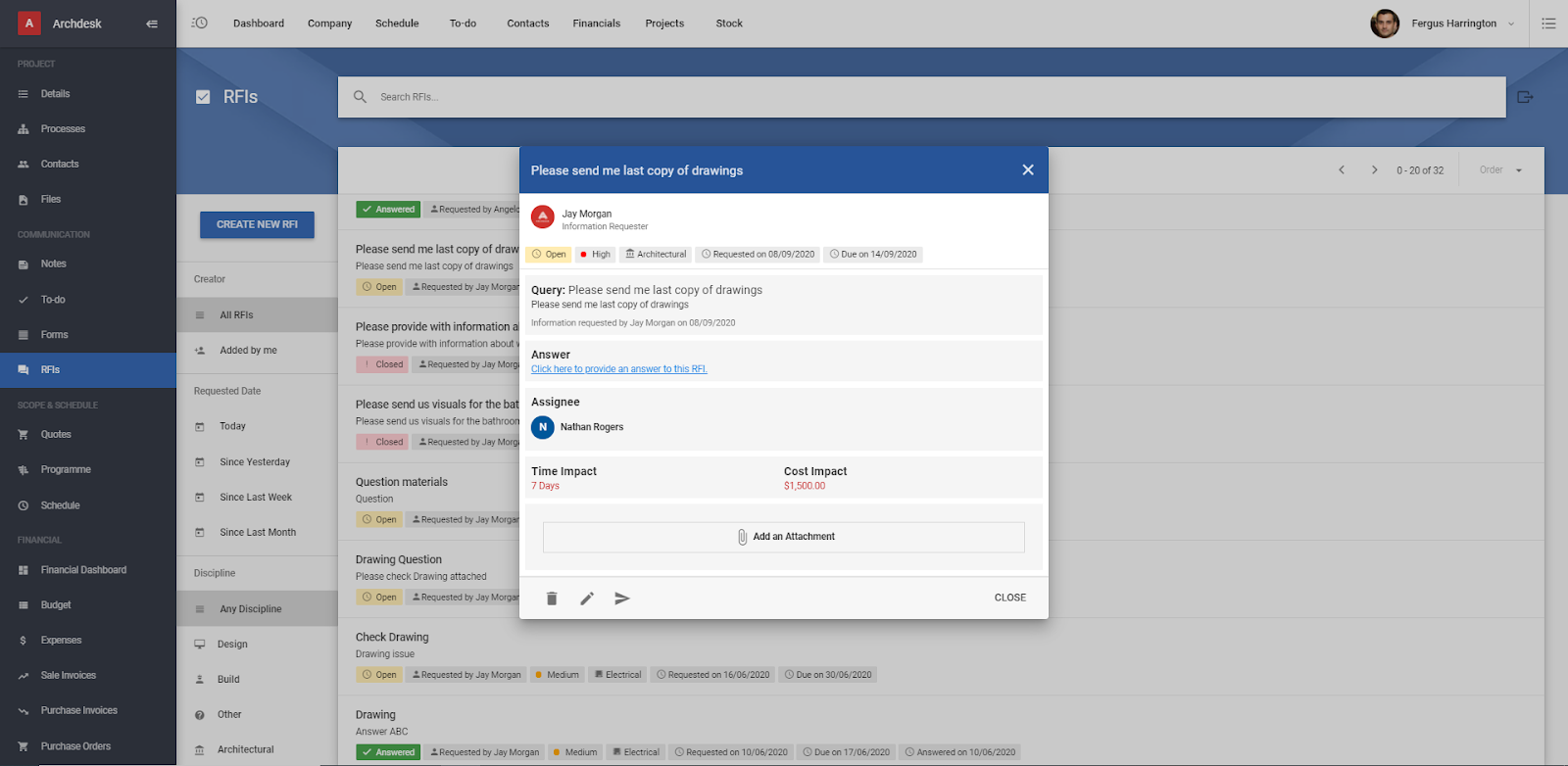Project Management: Handling RFIs in Construction
In construction, the smooth flow of information in our industry becomes a must-have for successful project delivery.
But how to provide a fast flow of information in external and internal communication?
Today you will find out what you need to know about the construction RFI process.
What Is a Construction RFI in project management?
RFI stands for Request for Information and refers to a project communication management process used to ask for some crucial project-related information from an initial design to detailed specifications.
The main aim is to assure the clarity of decisions in the project and eliminate uncertainty at each stage of execution. Usually, the information provided by RFI is not precisely defined in the contract agreement.
RFI requests may concern drawings, specifications, use of materials or unclear decisions in the first project's scope sent by the general contractor or subcontractor.
See the 9 best construction RFI software and tools in 2022
What Is the RFI process in construction?
It is hard to define the place of RFIs in the construction delivery process. Actually, you can use RFIs anytime between the project inception to final delivery.
How Does the RFI Process Work?
Imagine you are a subcontractor, and while doing your work, you find out that the general contractor in the contract did not specify which materials should be used. In such a case, you can create an RFI and send it directly to the general contractor.
If the process is being done by the construction management software, such a document is immediately visible to the project manager, who controls the whole process.
Employees with access rights can see the RFI, and in case of a similar situation, they already know the answer and do not have to stop their work.
We have mentioned here a construction management platform. The whole process can be handled with the use of modern digital solutions that speed up (and control) your processes.
Creating construction RFIs
Get your 10 free downloadable RFI templates here.
How to create a proper Request for Information? The whole process is not that complicated, but there are some crucial parts that your document should have:
-
Project title - remember to always add the project that the RFI concerns.
-
The subject of the document - a concise title that will allow you to understand what the paper will be about.
-
Importance - it is crucial to give your recipient an idea of the seriousness of the document, which can additionally motivate them to answer quicker.
-
Requested by - always register who sent the RFI as it will establish clear responsibility for the papers.
-
Request date - same as the point above, register the sent date to have control over documentation.
-
Due date - attach a deadline to each answer. Remember to give enough time as the requests with a due date today/tomorrow might look like you do not have control over the project.
-
Short description - sometimes, the title is not enough. It is also good to provide a few sentences that will explain the situation. Try to keep it consistent, focusing on who? what? where? why? and how?
-
Assigned to - it is not a must, but it is always good to add information about who is responsible for providing the answer from the customer's side to ensure process clarity.
-
Discipline - when the project is extensive and requires work from different disciplines, it is good to specify that in the RFI as well.
-
Time impact - crucial information! If requested information might extend the delivery date (for example, due to additional work), you need to add this in the RFI. Otherwise, the decision-making person does not have a complete picture of the situation of the project.
-
Cost impact - similar to the time impact. Add any additional cost that may be caused by a specific decision. Sometimes, it is hard to calculate, but the more precise sum you give, the better.
Submittal vs RFI
Often in the construction industry, you see Submittal instead of RFIs. Submittal is a piece of information (written or spoken) from the contractor to the general contractor.
It is usually regarding the approval of equipment, materials and design before being implemented in the project. The aim is to check with the general contractor if the items are in line with those initially planned in the project.
For example, architects and engineers often use submittals to make sure that the goods align with the initial plans.
RFI and submittal processes are pretty similar, but what differentiates them is the primary goal of these documents.
Submittals go into more detail than contracts and assure that subcontractors understand the design intent of the general contractor.
RFIs, on the other hand, are used to clarify, ask and precise the design intent of the project. But, what is crucial, neither of them can change the design intent.
Construction RFI, RFP or RFQ?
In a construction project, you can request not only information! For successful construction project management, you can also use RFP and RFQ. Before you feel discouraged by the number of abbreviations, let us explain them to you briefly.
Request for Information (RFI)
Our primary interest in this article. It is used for gathering information or making sure about specific decisions. Usually, used to communicate between the parties already connected by contract.
Request for Quotation (RFQ)
Used in procurement processes when you want to buy a specific material but need to learn all the financial details. Usually, more structured and prescriptive than RFI, focused mainly on the relation between cost and features.
Request for Proposal (RFP)
Similar to RFQ but the primary interest is not cost but the features of material/service. Such a document is more direct and formal and aims to compare different vendors and their offers.
Why are RFIs Important?
Why do I need a template with so many details if I can just contact my clients directly? Well, if you manage a tiny business (2 or 3 employees), sure. But if your company has more than three employees or manages more than one project at a time, it would be impossible. Here are a few benefits of using an RFI:
-
RFIs can set up and streamline the whole communication process
-
RFIs can help organise documentation as all information is in standardised templates (stored inside document management software or Google Drive)
-
RFIs also speed up internal communication as all needed information about the document is visible to employees
Up to 56% or projects fail due to poor communication. A lack of contact with customers means 27% of companies with high project management maturity miss the project's original goals. The solution for that can be a proper request for information process.
Read about managing the RFI process at your company here.
Tips for a successful construction RFI Process
- Set realistic expectations
Do not expect to get an answer the same day or a day after, significantly when a decision can impact the time and cost of the project! People do not like feeling pressured, and they are less likely to respond when they see "urgent" on every document.
Of course, if the information is crucial, you can set it up as ASAP. However, if you feel like all cases are critical, you should reconsider the importance of your project's processes. - Propose the solutions
People appreciate proactiveness. If you want to set up a good relationship with your contractors or customers, each time you send an RFI, try to suggest solutions. You may get an answer quicker. - Keep it simple
You need to balance long messages with a detailed list of recommended solutions and brief sentences that do not tell much about the request.
When you create a description in the RFI, it is good to answer the questions: who? what? where? why? and how? For each of them, use a maximum of one sentence to keep it simple and informative. - Never assume
It's easy to assume the answer, especially when your experience gives you confidence. But RFIs keep you safe and prevent assumptions from leaving you in a tricky spot.
RFI Construction Software
We live in a world of technology. So why not give it a chance to support your processes? Modern construction project management software with customised tools can help you automate repetitive tasks, store all needed documentation and organise the construction processes.
How does construction software support the process of requesting information?
-
Customised RFIs templates in the software help you always receive the information you need
-
The software stores all RFIs, and you can access them with only a few clicks
-
On the dashboard, you can see the RFI's status, response, attachments and all the aspects we mentioned before
-
RFIs are visible in the software for all employees with respective access rights, which speeds up internal communication
-
The system automates the parts of the processes, making the whole operation run faster
If you want to learn more about how modern technology can support, more specifically, your needs, set up a free meeting with one of our consultants. Our goal is to support your project management the best we can, so do not hesitate to contact us!
1 Comment
You might also like
February 29, 2024 • 7 min read
Utilizing the human-first approach to construction projects to drive higher results.
July 3, 2023 • 6 min read
8 Best Construction Drawing Management Software (2023): A Comprehensive Guide
Find all the information you need about the construction drawing management software tools available on ...June 14, 2023 • 6 min read
The 11 Best PlanGrid Alternatives (2023)
Looking for a great alternative to PlanGrid software? Check out the 11 best construction software tools ...June 14, 2023 • 4 min read
How to win at CIS 340 and make taxes a breeze
CIS 340 is a legal obligation for contractors. But getting it right isn’t straightforward. Want ...









I always look forward to reading your articles. You obviously put a lot of effort into this post, and I appreciate that.
https://figarigroup.com